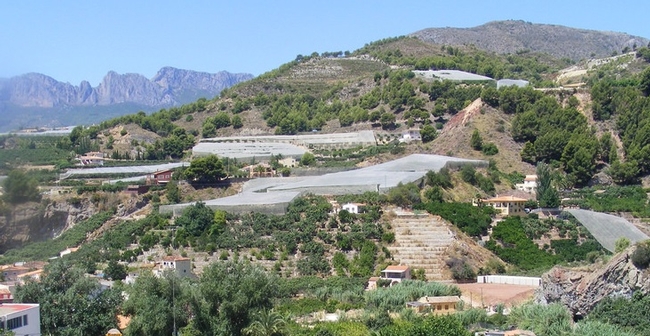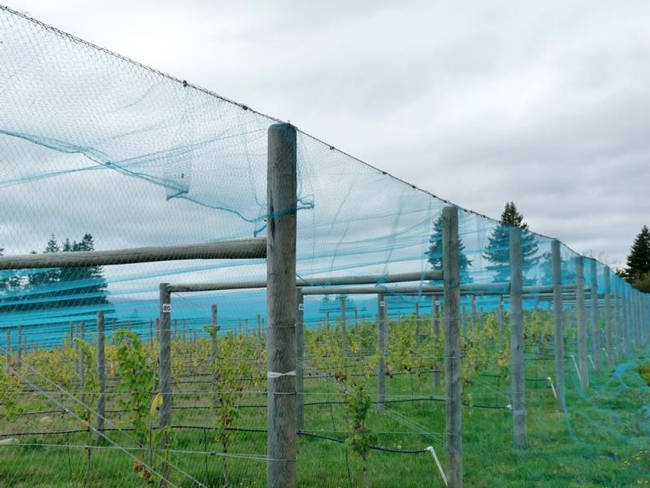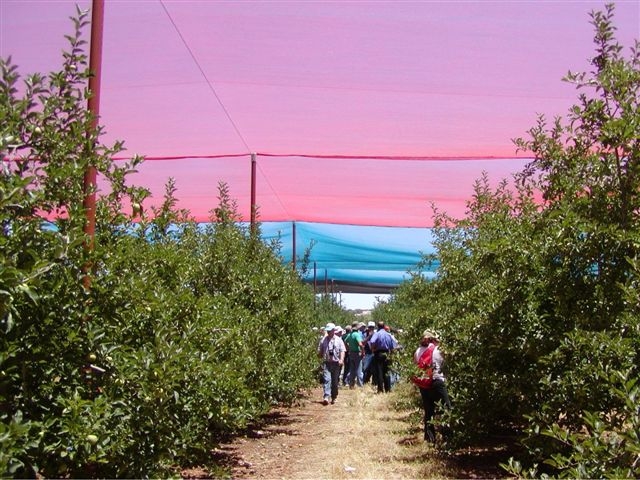
Posts Tagged: ACP. HLB
Citrus Has an Immune Response to HLB
LAKE ALFRED, Fla. — Sometimes in science, a new perspective brings an “a ha!” moment. That's what one senior researcher at the University of Florida Institute of Food and Agricultural Sciences believes happened with his latest research on Huanglongbing (HLB), or citrus greening.
HLB is worldwide, devastating citrus disease caused by Candidatus Liberibacter asiaticus (CLas), a bacterium that settles into the tree's phloem — its interior vascular system — eventually killing the tree. Since first found in Florida in 2005, it has infected virtually every grove in Florida and cost the citrus industry billions of dollars.
UF/IFAS' Nian Wang's most recent research describes in detail how HLB causes damage to citrus trees and presents the case that HLB is a pathogen-triggered immune disease. A pathogen-triggered immune disease is a disease that results from the activation of an organism's immune cells fighting a pathogen (a virus, bacteria, or parasite) that invades an organism, in this case, the citrus plant.
This is the first time that this explanation of HLB symptoms as pathogen-triggered immune responses has been presented and defended. Seeing HLB in this new context may mean finding new solutions to the disease, faster. Pathogen-triggered immune diseases have not been reported in the world of plants that includes over 250,000 species but are common in humans.
Scientists don't fully understand how the pathogen that causes HLB damages infected citrus plants because it has not been cultured in artificial media. With this new evidence that supports a premise that HLB is an immune-mediated disease, researchers can see new light on how to manage HLB.
Through his research Wang, has shown HLB infection stimulates systemic and chronic immune responses in phloem tissue, especially overproduction of reactive oxygen species (ROS), which are part of the plant's immune response. Chronic and excessive ROS production is responsible for systemic cell death of phloem tissues, which in turn causes HLB symptoms. This supports the hypothesis that HLB is an immune-mediated disease.
Antioxidants and immunoregulators are commonly used to treat human immune-mediated diseases. They halt or reduce the process that results in cell death. In citrus, the researchers tested whether growth hormones like gibberellin acid (GA) and antioxidants (uric acid and rutin) could impact cell death triggered by the infection and, therefore, block or reduce HLB symptoms.
The researchers found the GA and uric acid had an encouraging positive impact on infected trees. This has also been supported by other research in process at the UF/IFAS Citrus Research and Education Center.
“Our findings allow us to control HLB by mitigating ROS with integrated horticultural measures, genetic improvements of citrus varieties with antioxidant enzymes, generating non-transgenic HLB resistant/tolerant citrus varieties by editing key genes required for CLas-triggered ROS production, and using CTV-mediated expression of antioxidant enzymes and silencing of key genes required for CLas-triggered ROS production,” said Wang, a professor of microbiology and cell science at UF/IFAS.
Wang's research also tested existing grove management practices that integrate antioxidants, micronutrients (activating antioxidant enzymes), gibberellin (mitigating ROS, regulating immune response, and promoting new growth) and optimized fertilization and irrigation (reducing ROS production) that are available in Florida. All the products tested, except the antioxidants, have already been registered for citrus production, thus can be easily adopted by citrus growers.
Wang's research has also identified the RBOHD gene to be the main producer of CLas-triggered ROS. With this, the researchers can now “edit (using CRISPR technology)” or “silence” RBOHD or specific receptor gene(s) responsible for RBOHD activation and the resulting cell death of phloem tissues and HLB symptom development. It is expected these approaches will allow economic and efficient citrus production in HLB endemic citrus production regions such as Florida and Texas and provide the long-term solution against HLB for all citrus production regions of U.S. (including California) in case that HLB becomes endemic in the future.
Read the whole story:
Key Points About Plant "Immunity"
-
Unlike vertebrates, plants do not have an adaptive immune system. Nonetheless, plants can launch specific, self-tolerant immune responses and establish immune memory.
-
To promote virulence, pathogens inject effector molecules that target conserved immune signalling hubs into the plant cell. In response, plants have evolved resistance (R) proteins that detect effector-induced perturbations in these hubs, providing the potential to specifically recognize a large number of pathogens with similar infection strategies through a smaller number of R proteins.
-
Intraspecific and interspecific plant crosses suggest that autoimmunity can arise from self-reacting R proteins, illustrating the threat of uncontrolled R protein activity. Dynamic transcriptional and post-transcriptional regulation of R protein levels is thought to minimize the risk of autoimmunity in plants.
-
Pathogen-infected tissues generate a mobile immune signal consisting of multiple proteins as well as lipid-derived and hormone-like molecules. These signal molecules are transported to systemic tissues, where they induce systemic acquired resistance (SAR). SAR is associated with the systemic reprogramming of thousands of genes to prioritize immune responses over routine cellular requirements.
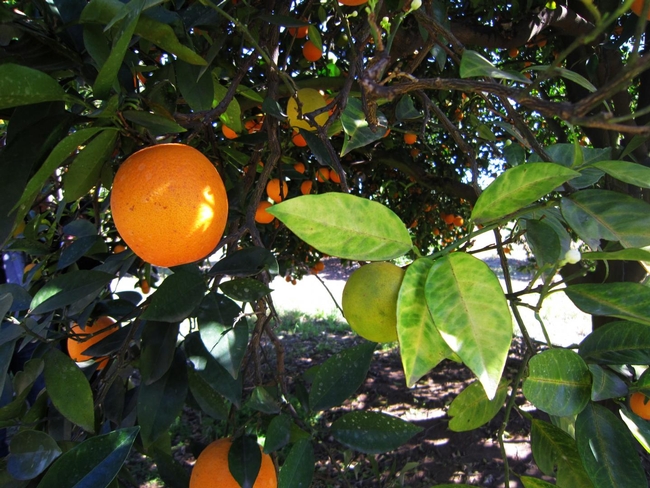
hlb infection
Netting in Your Orchard's Future?
At a recent meeting for current and prospective avocado growers near Visalia, Yosepha Shahak a retired researcher from Israel's Volcani Institute presented information on photo-selective netting. This netting was an outgrowth of netting that is used in the Mediterranean region to protect crops from frost damage and the unpredictable hail storms that can occur just as fruit might be coming to harvest. Netting is currently used in commercial orchards and vineyards throughout Europe. San Joaquin Valley growers like the idea of frost protection.
Netting over loquats (nespero) in Spain (Espana)
Netting over apples in Australia
Netting for light modification in Israel. Tractors can work here.
Photo-selective netting refers to covering crops by nets having the capacity to selectively filter the intercepted solar radiation, in addition to their protective function. The technology is based on plastic net products into which light dispersive and reflective elements are introduced during manufacturing. These nets are designed to screen various spectral bands of the solar radiation, and/or transform direct light into scattered light. The spectral manipulation intends to specifically promote desired physiological responses, which are light-regulated, while the scattering improves the penetration of the modified light into the inner plant canopy. So, depending on the crop, more and better fruit set, bigger fruit and some other desirable properties. The netting can also substantially reduce evaporative demand and wind damage. This can lead to not only lower water use, but also such water stress related diseases, such as blight caused by Botryosphaeria fungi. Lower evaporative demand and less water application can lead to less salt damage.
A recent additional aspect to the photo-selective nets refers to their effects on pest behavior. The photo-selective netting concept was developed and tested in Israel in ornamental, vegetable and fruit tree crops. It is gradually spreading all over the world, for implementation in different crops, climatic regions and cultivation methods. Applying it to avocado orchards is going to require pruning and keeping trees so that they can be picked and pollinated. And would probably lead to high density orchards.
And how we do pest management – more or less, and maybe not by helicopter?
This might also be the future for how citrus is grown in an HLB environment. 24 sprays a year to control ACP in Florida -Yikes.
A link to a Shahak talk that she gave to Washington state apple growers can be found at:
Citrus Seminar - Next Week
|
|
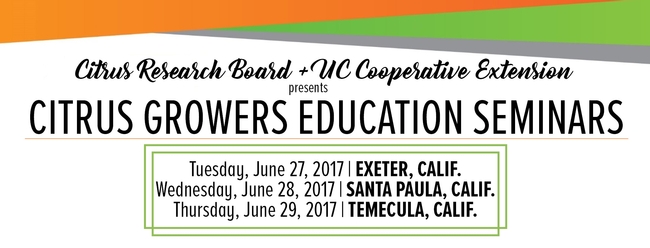
crb flyer 2017
The Citrus Research Board and Growers
Funding of the Citrus Research Board is an investment in pertinent research that supports the industry, making the information accessible to all within the industry from pest control advisors to packing houses to farm managers and others within the industry. The goal is to get the research done and then make sure it is used. CRB represents both large and small growers throughout California.
CRB research programs are funded by grower assessments which attract both federal and state funding, funding which represents a third of the total budget. This funding is used to support such projects as, HLB-resistant citrus rootstocks; the development of effective, low-cost HLB early detection technologies to rapidly remove infected trees; improved biocontrol methods for specific insect control like Asian citrus psyllid, as well as others; pre-and post-harvest citrus research to maintain export markets, amongst many other research programs.
The Citrus Research Board also supports the Citrus Clonal Protection Program (CCPP) with the goal of insuring the safe introduction of citrus varieties, disease diagnosis and pathogen elimination of introduced varieties and the maintenance and distribution of introduced varieties. CCPP serves as the primary source of clean, disease-free budwood and new varieties from Florida. This work is a collaboration between the Citrus Nursery Board, the University of California and State and Federal Regulatory agencies. The CCCP has become a major hub of the National Clean Plant Network for Citrus, resulting in the collaboration with 10 citrus centers in nine states and territories with multimillion dollar funding in support of CCCP's operations.
CRB research supports the California Citrus Quality Council (CCQC) with the primary objective of ensuring that California citrus meets domestic and international phytosanitary, food safety, food additive and pesticide residue regulations. CCQC ensures that California citrus growers have access to export markets for their fresh citrus fruit. Exports represent a third of the California citrus grower profits.
CRB-funded research into the California citrus-breeding program has led to the development of the Tango mandarin, along with others. The core breeding program conducts yield trials throughout the state on all varietal types to give growers information on upcoming new varieties and rootstocks. There is ongoing work to incorporate molecular tools to expedite breeding efforts to find plant materials resistant to HLB.
Along with CRB funding for cutting-edge projects for pest and disease control strategies, the CRB-funded CORE IPM Program led by Beth Grafton-Cardwell has responded to citrus grower needs for modifying existing spray schedule to treat Asian citrus psyllid. The program evaluates rotational sprays at appropriate times to avoid pesticide resistance to ACP.
Finally, this CRB-packaged information has been extended to growers through programs, including: The California Citrus Conference, Post-Harvest Conference and Seminar, and Regional Grower Education Seminars. CRB-funded research is compiled in Citrograph Magazine, the only magazine dedicated solely to the California citrus industry.

citrus and mountains
Resistant Citrus Selections to HLB?
Three citrus trees that produce inedible fruit at the UC Lindcove Research and Extension Center in Visalia may be a game-changer for the citrus industry, reported Ezra David Romero on Valley Public Radio.
The trees are thought to be resistant to huanglongbing, a severe disease of citrus that has devastated the Florida industry and could become a serious problem in California. The citrus-saving potential of the three 34-year-old trees was outlined in an article by UC Agriculture and Natural Resources writer Hazel White in the most recent issue of California Agriculture journal.
UC Riverside citrus breeder Mikeal Roose collected seed from the trees and will test seedlings as soon as they are large enough.
"So what (breeders) have to do is cross this with some edible varieties and eventually create something that has the gene for resistance, but also the genes for good fruit," said Beth Grafton-Cardwell, Lindcove director and research entomologist.
Huanglongbing disease has cut citrus production in Florida by more than half. It's been found in residential citrus trees in Southern California, but hasn't reached the state's vast commercial orchards yet. Grafton-Cardwell said she expects the disease will arrive in 4 or 5 years.
Yeah!!!!
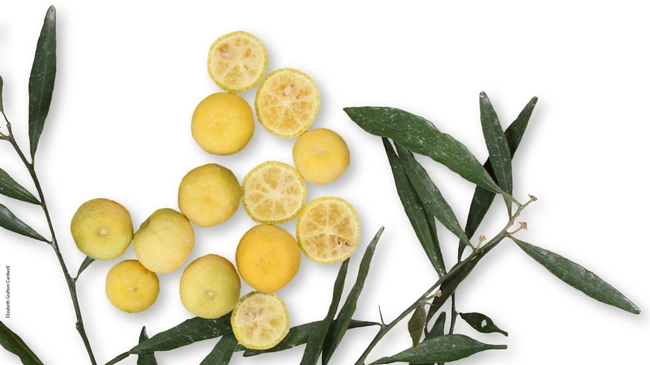
HLB resistant variety

